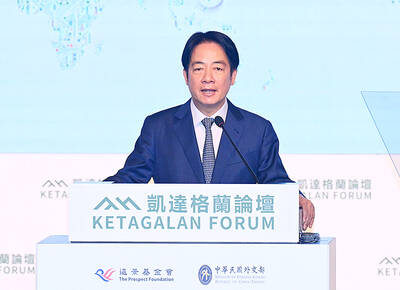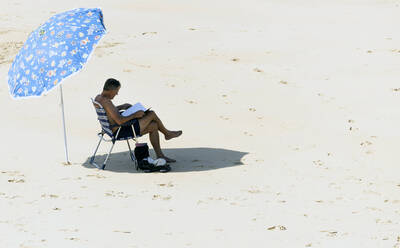A group of young Japanese tourists oohed and ahhed as svelte acrobats in traditional Chinese costumes did flips, splits and formed human pyramids while spinning plates. Two Western visitors arrived late for the show, just in time to see another acrobat execute complicated gymnastic maneuvers as he carefully stacked eight chairs on top of one another while simultaneously climbing them until he could nearly touch the theater’s ceiling.
Although Canadian performance troupe Cirque du Soleil’s ongoing 56-show run of Alegria in Taipei sold out months in advance — prompting the company to add Taiwan to its regular Asian touring schedule — the homegrown Chinese Acrobatic Troupe of the National Taiwan College of Performing Arts (國立台灣戲曲學院) finds itself relying on foreign tourists and students to fill seats at its twice-weekly shows in Neihu.
Founded in 1990, the Chinese Acrobatic Troupe is Taiwan’s first and only professional acrobatic company. It currently employs about 40 people, each of whom boasts at least 10 years of experience performing Chinese variety art. As a national theater company partially subsidized by the government, the troupe has traveled to more than 50 counties and performed in front of packed houses during three tours of Canada and the US between 2000 and 2005. In China, it has gone head-to-head against Chinese companies and won trophies at acrobatic art competitions.
Back home, however, the Chinese Acrobatic Troupe enjoys sparse attention from Taiwanese audiences, in part because of lack of money for publicity but also due to the perception that its shows are too traditional. The troupe began to embrace change three years ago, after the government reduced funding, adding non-traditional elements such as storylines to its shows, hiring theater directors and introducing a large-scale annual production in a bid to increase local interest.
“We were known as a Chinese variety art troupe performing traditional acrobatic routines,” said Liang Yueh-ying (梁月孆) who has been the troupe’s director for the past five years. “But now we are adding theatrical elements [to our repertoire] to become a performance art group.”
In 2005, the Chinese Acrobatic Troupe began experimenting with different styles and started working with theater directors such as France’s Philippe Goudard.
For its latest yearly production, Love Rhapsody (逗囍狂想曲), the crew of acrobats teamed up with experimental theater director Wang Jia-ming (王嘉明) to tell the story of a romance between a little boy and a little girl. Love Rhapsody will be staged at Metropolitan Hall (城市舞台) on Feb. 4 and Feb. 5 and is scheduled to tour to Keelung and Hsinchu in April and May.
Wang has given the production an almost surrealist feel by playing with concepts of time and space. Love Rhapsody also features dreamlike fantasy sequences and whimsical characters including a magician and bicycle-riding angels.
Liang said she hopes the media hype surrounding Cirque du Soleil’s Taiwan tour will fuel interest in Love Rhapsody, although she noted that it seems to have yet to influence attendance at the troupe’s weekly shows in Neihu.
Lo Fei-hsiung (羅飛雄), the troupe’s art director and also an accomplished magician, bemoans the difficulty of nurturing and holding on to young talent in an art that has long been overlooked and marginalized.
“How many stage directors specializing in the acrobatic art do we have in the country?” said Lo, who has worked with the troupe for the past 18 years. “None.” Acrobats with 40 years of experience can’t find teaching jobs at universities, he noted. Such jobs, he said, go to students who spend two years abroad to obtain a master’s degree from a foreign university.
Veteran acrobats like Ku Su-ling (古素玲) have devoted their entire lives to studying Chinese variety art and, later, performing with the troupe.
Admitted to acrobat school at the age of 10, Ku and her classmates would start their morning training at 6:30am, enjoy a short breakfast break at around 8am, then continue practicing until noon.
Last September, after two decades in the business, Ku fell from a human pyramid during a show. She injured her spine and will be unable to perform for at least six more months.
“We get hurt quite often,” she said, noting that two junior performers recently received had their knees replaced with prosthetic joints.
Although it takes years for acrobats like Ku to hone their skills, master old stunts and invent new routines, most can only look forward to a relatively short life as an artist on stage, and they leave with little recognition and few career prospects.
“My heart aches to see a 40-year-old acrobat who can’t jump or flip any more,” Lo said.
The Chinese Acrobatic Troupe of the National Taiwan College of Performing Arts does demonstrations of traditional Chinese variety art with elements of contemporary theater each week at 10am on Mondays and Thursdays at Bihu Theater (碧湖劇場), 177, Neihu Rd Sec 2, Taipei City (台北市內湖路二段177號). The program changes every two months. Groups of more than 30 people are advised to reserve space in advance by calling (02) 2796-2666 X1631 or X1634. Tickets cost NT$400, or NT$200 for students.

Following the shock complete failure of all the recall votes against Chinese Nationalist Party (KMT) lawmakers on July 26, pan-blue supporters and the Chinese Communist Party (CCP) were giddy with victory. A notable exception was KMT Chairman Eric Chu (朱立倫), who knew better. At a press conference on July 29, he bowed deeply in gratitude to the voters and said the recalls were “not about which party won or lost, but were a great victory for the Taiwanese voters.” The entire recall process was a disaster for both the KMT and the Democratic Progressive Party (DPP). The only bright spot for

As last month dawned, the Democratic Progressive Party (DPP) was in a good position. The recall campaigns had strong momentum, polling showed many Chinese Nationalist Party (KMT) lawmakers at risk of recall and even the KMT was bracing for losing seats while facing a tsunami of voter fraud investigations. Polling pointed to some of the recalls being a lock for victory. Though in most districts the majority was against recalling their lawmaker, among voters “definitely” planning to vote, there were double-digit margins in favor of recall in at least five districts, with three districts near or above 20 percent in

The great number of islands that make up the Penghu archipelago make it a fascinating place to come back and explore again and again. On your next trip to Penghu, why not get off the beaten path and explore a lesser-traveled outlying island? Jibei Island (吉貝嶼) in Baisha Township (白沙鄉) is a popular destination for its long white sand beach and water activities. However, three other permanently inhabited islands in the township put a unique spin on the traditional Penghu charm, making them great destinations for the curious tourist: Yuanbeiyu (員貝嶼), Niaoyu (鳥嶼) and Dacangyu (大倉嶼). YUANBEIYU Citou Wharf (岐頭碼頭) connects the mainland

For their 15th wedding anniversary, Katie Walley-Weigert and her husband decided to take a beach vacation with their young son. But the trip didn’t go as planned. Walley-Weigert wound up needing to pack her computer because of a work assignment she couldn’t ignore. The 38-year-old marketing professional had just landed a podcast interview for an executive she worked with, and he had a short window to prepare. As she labored away through most of the vacation, she regretted not being present for her toddler’s introduction to the ocean. “I know my husband and my son are having this once-in-a-lifetime first experience, and